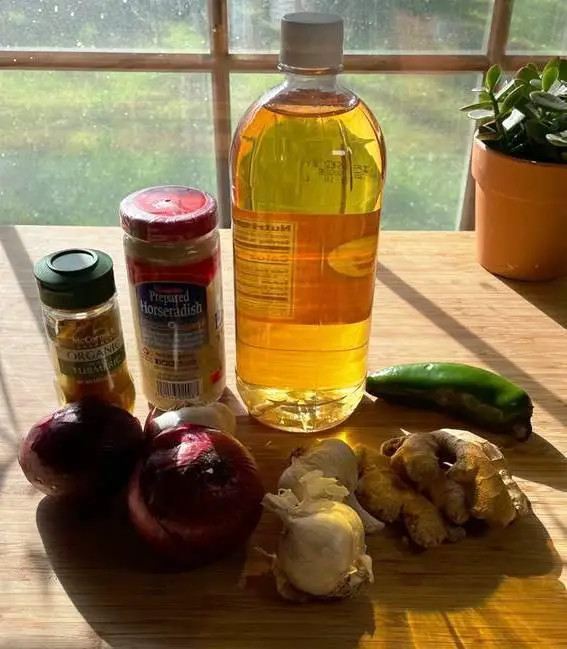Estimated reading time: 9 minutes
The fall and winter months can be draining from the lack of sunshine, the chill in the air, and the onslaught of germs that never seems to end! I’m trying something new to ward off those winter chills this year.
I’m making fire cider. This traditional recipe uses common ingredients to create a spicy drink that warms the body and is thought to boost the immune system.
Want to save this post for later? Click Here to Pin It On Pinterest!
What Is Fire Cider?

Fire cider is an old-fashioned herbal remedy thought to help warm you up, boost immunity, and help with digestion. A typical fire cider recipe includes horseradish, ginger, garlic, hot peppers, and apple cider vinegar, giving it a fiery flavor.
The concoction needs to steep for at least two weeks. Then, it can be used as a daily immune booster, to ward off a cold, or just to warm up! Some people will take a small shot of the spicy drink, while others prefer to dilute it in juice or tea, mix it with oil as a salad dressing, or drizzle over roasted veggies.
What Are the Benefits of Drinking Fire Cider?
Keep in mind that fire cider is an old-fashioned herbal remedy. There still isn't a lot of scientific evidence supporting the use of fire cider, but tradition says it has all sorts of benefits:
Boosts Immune Function: Many of the ingredients in fire cider, such as garlic, ginger, and hot peppers, are known for their immune-boosting properties. Garlic, for example, contains allicin, a compound with potent antimicrobial properties that may help fight off colds and infections.
Aids Digestion: Apple cider vinegar is a well-known digestive aid, often used to stimulate digestive enzymes and improve nutrient absorption. Ginger is another digestive powerhouse, traditionally used to soothe nausea, improve digestion, and reduce bloating.
Supports Respiratory Health: The combination of horseradish, hot peppers, and garlic can help to clear the sinuses and ease respiratory congestion. Horseradish, in particular, has been used for centuries to open up nasal passages and relieve sinus pressure.
Anti-Inflammatory Properties: Many ingredients in fire cider, especially turmeric and ginger, are known for their anti-inflammatory benefits. Chronic inflammation is linked to a wide range of health issues, including heart disease, arthritis, and digestive disorders.
Improves Circulation: The spicy ingredients in fire cider, such as hot peppers and ginger, can stimulate circulation. This can help to warm the body from the inside out, making fire cider especially comforting during cold weather.
Blood Sugar Regulation: Apple cider vinegar has been studied for its potential to help regulate blood sugar levels. Some research suggests that consuming vinegar with meals may improve insulin sensitivity and lower blood sugar spikes.
What is Fire Cider Made of?
You’ll find there are a lot of different variations of fire cider, but there are several core ingredients that give this drink its fiery taste and immune-boosting benefits.

- Apple Cider Vinegar – may have probiotic and digestive benefits
- Ginger – often used for nausea and digestive issues
- Garlic – is considered to be antimicrobial, anti-inflammatory, and antifungal
- Onions – may have antibiotic and antioxidantqualities
- Hot peppers – Hot peppers have vitamin C as well as Capsaicin, which is thought to have antimicrobial properties
- Horseradish – may have anti-inflammatory and antibacterial properties from lab studies.
There are plenty of optional ingredients that you can use to adjust the flavor and properties of your fire cider. You can include:
- Lemon or oranges
- Fresh herbs such as rosemary, thyme, and oregano
- Turmeric for its anti-inflammatory properties
- Honey for its antimicrobial properties and sweet flavor
Fresh ingredients are considered to be the best. However, if you don’t have access to fresh ingredients, dried herbs and powders will also work!
How to Make Fire Cider
Fire Cider Ingredient List:
- 24 ounces apple cider vinegar
- ¼ cup garlic, finely chopped
- ¼ cup onion, finely chopped
- 2 fresh hot peppers (I only used one)
- ¼ cup grated ginger
- 2 tablespoons grated horseradish
- 3 tablespoons turmeric
- 2 tablespoons oregano
- 2 tablespoons thyme
- ¼ cup raw honey (to be added later)
I didn’t go too crazy trying to measure out all my ingredients. I just approximated the amounts of each, although I admit that I went a little heavy with the garlic and onion and a little lighter on the hot pepper because I don’t like foods that are very spicy.
You can adjust your ingredients to taste. However, it’s critical to have enough apple cider vinegar to cover all of the other ingredients in your jar. Everything must be submerged so that it doesn’t go bad.
Directions to Make Fire Cider

- Gather all your ingredients and decide what you want in your fire cider. For it to be palatable to me, I went easy on the hot peppers but made up for it with garlic and onion.

- Finely chop the garlic, onion, fresh herbs, and hot pepper. The hotter the pepper, the more careful you need to be. You may want to wear gloves and eye protection and be sure you don’t rub your eyes when you are working with hot peppers! It will burn.

- Grate your ginger, horseradish, and turmeric root. I like to use a glove made to protect your fingers so you don’t accidentally grate them, too!

- Layer your ingredients in a large mason jar.

- Pour enough apple cider vinegar into the jar to submerge all of your ingredients. Put a lid on the jar and give it a good shake.

- Allow your fire cider to steep for at least two weeks, shaking it daily. It is even better if you can let it steep for a month. The color will darken and change over time.
- Strain your fire cider with a cheesecloth laid over a strainer or colander.
- Add honey to taste to the liquid. You can throw out the leftover pieces of ginger, onion, etc.
- Store your fire cider in a cool, dark place for up to a year. I prefer to store mine in the refrigerator to be safe, although fire cider is considered shelf-stable.
- Drink as needed!

Fire Cider Variations
One of the great things about fire cider is its flexibility. While the core ingredients—such as apple cider vinegar, garlic, ginger, and hot peppers—remain consistent, you can easily customize your fire cider to suit your taste preferences or specific health goals.
Here are a few ways to customize your fire cider:
- Immune-Boosting Additions – For an even stronger immune-boosting effect, you can add herbs and ingredients known for their immune-supportive properties such as echinacea or elderberry.
- Milder Flavor Options – If the traditional fire cider recipe feels too strong or spicy, you can mellow out the flavor by using milder peppers or adding more honey.
- Extra Warming Spices – To enhance the warming properties of fire cider, you can add warming spices that also provide health benefits such as cloves, cinnamon, or cayenne pepper.
- Citrus Variations – Adding citrus such as oranges or lemons can give your fire cider a fresh, bright flavor while increasing its vitamin C content.
- Additional Herbs – Certain herbs can add more medicinal value to your fire cider while complementing its flavor. A few good ones include thyme, oregano, and rosemary.
- Anti-Inflammatory Enhancements – For those looking to reduce inflammation, adding extra anti-inflammatory ingredients can give your fire cider a more targeted benefit. Two of the best options are ginger and turmeric.
- Flavor Balancers – Sometimes the vinegar in fire cider can feel too strong, and balancing that with a bit of natural sweetness can improve the overall taste. I already mentioned honey, but you can also add maple syrup for a unique twist.
How Much Fire Cider Do I Need to Drink?
You can take one tablespoon of fire cider a day as an immune system booster. Take one tablespoon several times throughout the day to ward off a cold or illness.
Many people like to dilute the drink in a glass of juice or tea because the flavor is very spicy! You may want to be careful when you first start using the fire cider. Start with a smaller dose and make sure to take it with food until you are sure it won’t upset your stomach.
Just like any other spicy food, fire cider can cause your nose and eyes to run and reduce inflammation. Drink with caution!

Fire Cider
Equipment
- Mason jars with lids
Ingredients
- 24 oz apple cider vinegar
- 1/4 cup garlic, finely chopped
- 1/4 cup onion, finely chopped
- 2 fresh hot peppers
- 1/4 cup grated ginger
- 2 tbs grated horseradish
- 3 tbs turmeric
- 2 tbs oregano
- 2 tbs thyme
- 1/4 cup raw honey to be added later
Instructions
- Gather all your ingredients and decide what you want in your fire cider. For it to be palatable to me, I went easy on the hot peppers but made up for it with garlic and onion.
- Finely chop the garlic, onion, fresh herbs, and hot pepper. The hotter the pepper, the more careful you need to be. You may want to wear gloves and eye protection and be sure you don’t rub your eyes when you are working with hot peppers! It will burn.
- Grate your ginger, horseradish, and turmeric root. I like to use a glove made to protect your fingers so you don’t accidentally grate them, too!
- Layer your ingredients in a large mason jar.
- Pour enough apple cider vinegar into the jar to submerge all of your ingredients. Put a lid on the jar and give it a good shake.
- Allow your fire cider to steep for at least two weeks, shaking it daily. It is even better if you can let it steep for a month. The color will darken and change over time.
- Strain your fire cider with a cheesecloth laid over a strainer or colander.
- Add honey to taste to the liquid. You can throw out the leftover pieces of ginger, onion, etc.
- Store your fire cider in a cool, dark place for up to a year. I prefer to store mine in the refrigerator to be safe, although fire cider is considered shelf-stable.
How Much Fire Cider Do I Need to Drink?
- You can take one tablespoon of fire cider a day as an immune system booster. Take one tablespoon several times throughout the day to ward off a cold or illness. Many people like to dilute the drink in a glass of juice or tea because the flavor is very spicy! You may want to be careful when you first start using the fire cider. Start with a smaller dose and make sure to take it with food until you are sure it won’t upset your stomach. Just like any other spicy food, fire cider can cause your nose and eyes to run and reduce inflammation. Drink with caution!
Like this post? Don't Forget to Pin It On Pinterest!
You May Also Like:











